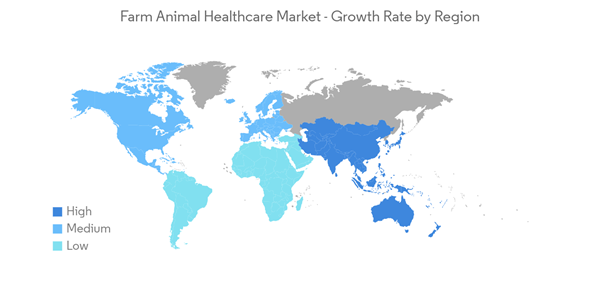COVID-19 has impacted the growth of the farm animal healthcare market owing to the lockdown measures imposed by the government which led to the suspension of animal healthcare services. For instance, according to an article published in the Indian Journal of Animal Sciences, in July 2022, it has been observed that the pandemic has created a serious impact on the livestock sector owing to the lockdown on animal health services delivery including vaccination, coping practices, and financial loss to farmers in Karnataka, India. Also, as per an article published in Translational Animal Science, in December 2021, the COVID-19 pandemic caused supply chain disruptions that increased stress, uncertainty, and time-sensitive challenges for producers in maintaining animal care at Lowa, United States. However, with the released restrictions the companies have resumed their clinical activities as well as product developments which have increased the market growth. Thus, the market is expected to grow over the forecast period.
Factors such as advanced technology leading to innovations in animal healthcare, growing initiatives by government and animal welfare associations in different countries as well as the increased productivity at the risk of emerging zoonosis are expected to boost the market growth over the forecast period.
The increasing government initiatives to promote various programs and campaigns to vaccinate farm animals are also expected to fuel the market growth. For instance, in March 2022, the United States Ambassador announced the launch of a new five-year project to vaccinate cattle against bovine tuberculosis.
Additionally, the emerging chronic and infectious diseases among the farm animals raise the demand for effective therapeutics products which in turn is anticipated to increase the market growth over the forecast period. For instance, as per an article published in Health and Medicine, in February 2022, a novel Hendra virus, a virus that can cause acute lethal respiratory and/or neurologic indications in horses, was discovered in Sydney. This virus is thought to be the cause of the deadly disease in Australian horses and is a threat to human health. In addition, as per the same source, the second case of the variant was confirmed by the New South Wales Department of Primary Industries near Newcastle in October 2021.
Furthermore, the rising product launches related to farm animals increase the availability of vaccines, medicated feed, and other products in the market, hence, contributing to the growth of the farm animal healthcare market. For instance, in April 2022, Boehringer Ingelheim launched PREVEXXION RN+HVT+IBD and PREVEXXION RN vaccinations for Marek's disease, a very common disease of chickens caused by a herpes virus, in Europe, including the United Kingdom and Germany. Also, in April 2022, Amlan International launched two new natural alternatives to antibiotics for poultry and livestock, Phylox Feed and NeutraPath, that can reduce the negative health and production effects of enteric disease. This launch assists the company to expand its broad portfolio of animal health feed additives to include a natural alternative to anticoccidial drugs and vaccines and a natural pathogen control product for antibiotic-free production.
Therefore, owing to the aforementioned factors, the studied market is expected to grow over the forecast period. However, the use of counterfeit medicines and the increasing cost of animal testing and veterinary services are likely to impede the growth of the farm animal healthcare market over the forecast period.
Farm Animal Healthcare Market Trends
Vaccines Segment is Expected to Witness Significant Growth Over the Forecast Period
Vaccines are biological preparation formulated to provide acquired immunity for particular diseases. The vaccines are used to treat various diseases in farm animals, such as clostridial diseases, Marek's disease, Newcastle disease, infectious bronchitis, infectious laryngotracheitis, fowl pox, fowl cholera, classical swine fever, foot and mouth disease, porcine parvovirus and others. Furthermore, new advanced vaccines have been manufactured containing genetically engineered components derived from those disease agents, which can protect farm animals from various infectious diseases and enhances their productivity.The vaccines segment is expected to witness significant growth in the farm animal healthcare market over the forecast period owing to factors such as the rising prevalence of zoonotic and chronic diseases, increasing product launches, growing awareness of animal health, rising investments by government bodies and associations, and increasing healthcare expenditure for farm animals. For instance, according to an article published in Frontiers in Veterinary Science in August 2022, it has been observed that numerous outbreaks of lumpy skin disease (LSD) were reported in Thailand in 2021-2022, affecting cattle farms. In addition, as per the same source, 133 LSD outbreaks were found in Thailand in 152 dairy farms from May to July 2021. Thus, the high number of LSD cases raises the company's focus on developing effective vaccines, which is anticipated to boost the segment growth over the forecast period.
Moreover, market players are developing and launching new vaccines globally to enhance their market presence, contributing to the segment's growth. For instance, in May 2022, Boehringer Ingelheim launched TwistPak, a revolutionary mixing platform. It enables swine producers to combine two vaccines, Ingelvac CircoFLEX and Ingelvac MycoFLEX, conveniently, quickly, and flexibly. The positive outcome from the undergoing vaccine candidates is further expected to impact the growth of the studied segment positively. Similarly, in December 2021, Indian Immunologicals Ltd (IIL) launched Goat Pox Vaccine (Raksha Goat Pox) to help control Goat Pox disease. Moreover, in August 2022, the Union Minister for Agriculture and Farmers Welfare, India, in collaboration with Indian Veterinary Research Institute, launched the indigenous vaccine Lumpi-ProVac to protect livestock from Lumpy Skin disease.
Therefore, owing to the rising incidences of lumpy skin disease among cattle and the new product launches, the studied segment is expected to grow over the forecast period.
North America is Expected to Have the Significant Market Share Over the Forecast Period
North America is expected to hold a significant share in the farm animal healthcare market over the forecast period owing to factors such as the rising burden of chronic and infectious diseases among farm animals, growing technological advancements, and the awareness of farm animal healthcare benefits.Additionally, the growing government initiatives and investments in launching various projects for developing effective medicines and therapeutics products for farm animals are expected to increase market growth over the forecast period. For instance, in March 2022, the United States Department of Agriculture awarded USD 642,000 to Cornell University to develop more effective swine influenza vaccines. Similarly, in March 2022, the United States Department of Agriculture (USDA) National Institute of Food and Agriculture (NIFA) invested USD over 13 million to research novel therapies and prevention strategies for animal diseases. These funds are used to develop effective drugs and medicines to treat infectious diseases in calves to improve livestock health.
Furthermore, the high burden of various diseases among farm animals in the region raises the demand for effective vaccines for their protection. For instance, according to the data published by the government of Canada in January 2022, African swine fever (ASF) is deadly for pigs. It is expected to destroy swine farming, impacting the Canadian economy. As per the same source, Swine Innovation Porc received about USD 446,135 in 2021 under the Canadian Agricultural Strategic Priorities Program to develop strategies to mitigate the impact of an African swine fever outbreak on the pork sector. Similarly, per an article published in Poultry Science, in October 2022, about 17 avian infectious bronchitis virus strains were obtained from chickens showing signs of illness in Mexico until 2021. Mexico's high genetic contagious bronchitis virus (IBV) diversity results from the co-circulation of divergent lineages belonging to different genotypes, and these lineages differ significantly from Massachusetts and Connecticut vaccine strains. This indicates the high demand for novel vaccines in the region, which is expected to propel the market growth over the forecast period.
Therefore, owing to the factors above, such as growing government initiatives and the high burden of diseases among farm animals, the studied market is expected to grow over the forecast period.
Farm Animal Healthcare Industry Overview
The farm animal healthcare market is competitive owing to the presence of many local and domestic players. The companies are adopting key strategic initiatives such as collaboration, partnerships, agreements, and other initiatives to withhold their market position by expanding their product offerings. Some of the key players in the market are Zoetis, Merck, Boehringer Ingelheim, Elanco, Vetoquinol, and Ceva Animal Health.Additional Benefits:
- The market estimate (ME) sheet in Excel format
- 3 months of analyst support
This product will be delivered within 2 business days.
Table of Contents
Companies Mentioned (Partial List)
A selection of companies mentioned in this report includes, but is not limited to:
- Boehringer Ingelheim International GmbH
- Ceva Animal Health Inc.
- Elanco
- Hester Biosciences Limited
- Merck & Co. Inc.
- Phibro Animal Health
- Vetoquinol
- Zoetis Inc.
- Intas Pharmaceuticals Ltd
- Norbrook
- Alivira Animal Health Limited










